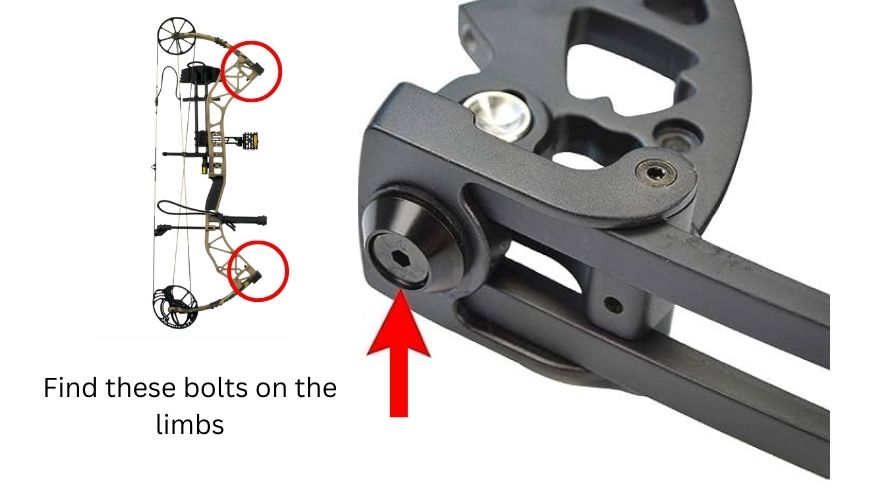Why to set draw weight on a bow? there could be multiple reasons, maybe because of shooting styles or because one can not hold the current weight. But what is important is how to adjust draw weight on a compound bow?
In this article, you will learn how to set your draw weight according to your preferences. The draw weight can be increased or decreased by tightening or loosening the limb bolts on the upper and lower limbs, which loads or unloads the tension in the limbs. You can check your bow’s limbs specific draw weight rating in the owner’s manual, as every bow has its own specific value.
Make sure to follow the safety precautions, as too much tightening can result in limb bolts damaging the riser, and too much loosening can cause limb bolts to slip out of the limb, causing injury to you or the bow in both cases.
Preparing For Draw Weight Adjustment
Before starting the process of adjusting, you must check your bow, and have the necessary tools.
Check If Your Draw Weight Is Adjustable
Most bows have adjustable draw weights but you must make sure that your bow has the bolts that allow for the adjustment of poundage. Check on the corners of the limbs (the point where the limbs meet the riser) to find the adjustment bolts that can loosen the tiller. If you don’t find any such bolts then unfortunately your bow has a non adjustable draw weight.

Tools For Draw Weight Adjustment
To adjust the draw weight of your compound bow, you’ll need a bow scale and an Allen wrench. The bow scale is used to measure the current draw weight, while the Allen wrench is used to adjust the limb bolts on your bow.
Determine your compound bow Range
Compound bows typically have an adjustable draw weight range specified by the manufacturer. This range can vary from one bow to another, but it generally falls between 10 and 70 pounds.
The range is defined as the minimum and maximum amount of force you can set the bow to exert when drawing the string. Look at the bow’s manual to see how much adjustment you can make.
Usually expensive bows have a low adjustment range this is because a high range can make it very difficult for the owner to balance the forces.

Safety Precautions
Before making any adjustments, unstring your bow to prevent injury or damage. Adhere to the manufacturer’s recommended draw weight range, use the correct size Allen wrench, and consult your bow’s manual for specific instructions.
How To Adjust Compound Bow Draw Weight Step-By-Step Guide
1. Measure the current draw weight
Unstring your bow: Before making any adjustments, ensure your bow is unstrung to prevent accidental release of the bowstring that can cause injury.
Measure the current draw weight: Use a bow scale to measure the existing draw weight. This measurement will serve as a reference point for your adjustments. A bow scale accurately measures the force required to pull the bowstring to its full draw position.
2. Adjusting the Limb Bolts
Locate the limb bolts: Find the limb bolts near the limb pockets of your compound bow. These bolts are typically in large circular knobs that attach the bow’s limbs (arms) to the riser.
Loosen the limb locking screws: Some compound bow models have a second set of bolts or screws that hold the limb bolts in place. Loosen these locking screws to allow for limb bolt adjustments. Take a few turn to loosen the locking screws and unlock the tiller bolts.
Use an Allen wrench: Insert the short arm of an Allen wrench (usually a 3/16 size, often included with the bow) into the bolt, ensuring it is properly slotted.
Adjust the limb bolts: In order to increase the draw weight, you have to tighten the bolt by turning the wrench clockwise. To decrease the draw weight, you have to loosen the bolt by turning the wrench anticlockwise. Make gradual adjustments, maintaining a balance between the upper and lower limbs.
Make turns alternatively: Don’t make 10 turns on one limb bolt and then take 10 turns on bottom limb bolt, do it alternatively. Make two turn on one bolt, then make two turn on another bolt and try those settings to see if its enough for you. Turning all the way can cause disbalance and snap your bow if you haven’t unstrung it. This can cause serious damage to the bow.

3. Fine-Tuning Draw Weight
Measure the new draw weight: After adjusting the limb bolts, use the bow scale again to measure the new draw weight. If the new draw weight is off a bit then try turning the limb bolts just a half turn or a quarter turn to fine tune it. Make these small adjustments until you get your desired poundage.
Measure the tiller distance: Tiller height is the distance between the string and the point of the limb where it meets the riser. Use a bow square to measure this distance. The tiller height should be same as before if you have adjusted the draw weight correctly. Tiller distance for upper and lower limb should be the same.
Tighten the locking screws: Make sure to tighten the locking screws, its important. Many people forget this step.

Determining Your Ideal Draw Weight
Factors Influencing Ideal Draw Weight
Consider your physical strength, experience level, and the type of archery activity you engage in when determining your ideal draw weight. Hunting typically requires higher draw weights for increased penetration, while target shooting demands a comfortable draw weight for consistent accuracy.
Finding Your Comfortable Draw Weight
Experiment with different bows to find your comfortable draw weight. Draw each bow several times and assess how it feels. Your ideal draw weight should allow you to draw the bow smoothly and hold it at full draw for at least 10 seconds without shaking or straining. Start with a lower draw weight if you’re a beginner, gradually increasing it as you build strength and experience.
Average Draw Weight Table
Below is a table with some recommended ranges for people with different age groups. It is preferred to consider your draw weight when buying the compound bow.
| Archery Skill Level | Gender | Age Group | Recommended Draw Weight Range (in pounds) |
|---|---|---|---|
| Beginner/Youth | Any | Children (under 12) | 10 – 25 |
| Male | Teenagers (13-17) | 15 – 30 | |
| Female | Teenagers (13-17) | 10 – 25 | |
| Intermediate | Any | Adults (18-40) | 30 – 50 |
| Male | Adults (41+) | 30 – 50 | |
| Female | Adults (41+) | 25 – 40 | |
| Experienced | Any | Adults (18-40) | 40 – 60 |
| Male | Adults (41+) | 40 – 60 | |
| Female | Adults (41+) | 30 – 50 | |
| Competitive/Pro | Any | Adults (18+) | 50 – 70 |
The Impact Of Draw Weight Adjustment On Bow Performance
The change in draw weight can have some positive and negative impacts on your or your bow’s performance.
Arrow Trajectory
Changing the draw weight alters the arrow’s trajectory and impact point. A higher draw weight results in a flatter trajectory, potentially improving accuracy. Striking the right balance between draw weight and accuracy for your specific archery activities is crucial.
Arrow Speed
Increasing draw weight enhances arrow speed and penetration power, which is particularly important for hunting. However, for target shooting, maintaining a comfortable draw weight is more important for consistent accuracy.
Physical Performance
A higher draw weight can cause fatigue and makes you tired quickly. It is also difficult to hold the draw weight at full draw. So for target archery you might not want a very high poundage.
What Happens When You Adjust Draw Weight
FAQs
How can I improve my bow draw weight?
To increase your bow’s draw weight, you can turn the limb bolts clockwise, making sure to adjust both limbs equally. Gradual adjustments are key to maintain balance and safety.
Can you adjust draw weight without a bow press?
Yes, you can adjust draw weight without a bow press by using the limb bolts. However, some high-end bows may require a bow press for major changes or cam module adjustments.
Will adjusting draw weight affect accuracy?
Yes, draw weight adjustments can impact accuracy. It makes holding and aiming the bow difficult if draw weight is too much for you. It’s essential to find a comfortable weight that matches your skill level to maintain consistent and accurate shooting.
How do I choose a compound bow draw weight?
Select a draw weight based on your physical strength, experience, and intended use. Start with a weight you can comfortably handle, and slowly increase it according to your needs.
Conclusion:
Adjusting the draw weight to your preference ensures a comfortable and accurate shooting experience. By tailoring draw weight to your specific needs, you can improve your performance in various archery activities, whether hunting or target shooting.
After adjusting the draw weight, re-tune your bow and adjust your sights to maintain accuracy. Regularly inspect your bow for wear and tear, making necessary adjustments to maintain a consistent draw weight. Fine-tuning your equipment is essential for mastering the art of archery.
